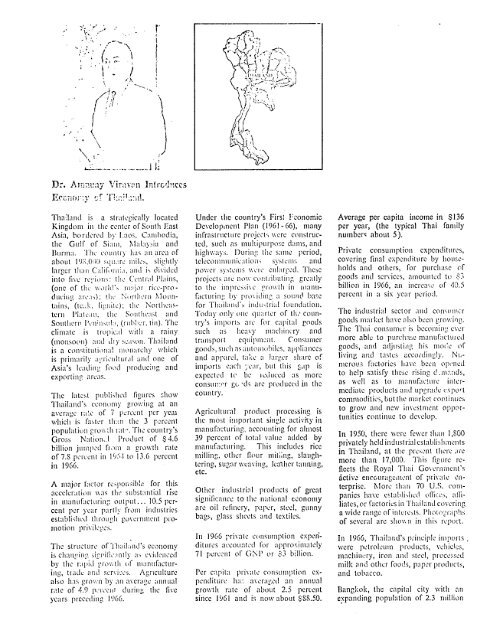pnarc180.pdf
pnarc180.pdf
pnarc180.pdf
You also want an ePaper? Increase the reach of your titles
YUMPU automatically turns print PDFs into web optimized ePapers that Google loves.
4" '.k <br />
/\tL ,<br />
\f'"l % a sound base<br />
for Thailalnd'*. iildutrial foundation.<br />
Today only one qlartcr of th., country's<br />
imports are for capital goods<br />
such as heavy niaclhinry and<br />
transport equipment. Consumer<br />
goods, such as antoiiobiles, a)jlianccs<br />
and apparel, takc a larger share of<br />
imports each gear, but this ,tp is<br />
expected to be ICduced as more<br />
consuror go &(isare produced in the<br />
Agricultural product processing is<br />
the most imaportant single activity in<br />
mannfacturing, accounting for almost<br />
39 percent of total value added by<br />
nanfacturing. This includes rice<br />
milling, other flour niiit;ng, slaughtering,<br />
sugarweaving, lealier tanning,<br />
etc.<br />
Other industrial prodlcts of great<br />
significance to the national economy<br />
are oil refinery, paper, steel, gunny<br />
bags, glass sheets and textiles, .of<br />
In 1966 private consumption expen'-<br />
ditures accounted for approximately<br />
71 percent of GNIP or $3 billion.<br />
Per capita private consumption expenditurc<br />
ha:: averaged an annual<br />
growth rate of about 2.5 percent<br />
since 1961 and is now about $88.50.<br />
Average per capita income in S136<br />
per year, (the typical Thai family<br />
numbers about 5).<br />
Private consumnpt ion expenditures,<br />
covering final expenditure by households<br />
and others, for purchase of<br />
goods and services, amountcd to 3<br />
billion in 1966, an increae;.; of 40.5<br />
percent in a six year period.<br />
rhe industrial sector and comsumr<br />
goods market have ilso been growing.<br />
The Thai consunr is bccotnin ,ever<br />
more able to purchzase manufa cttucd<br />
goods, and adjusting his mode of<br />
living and tastes accordingly. N ,<br />
merous factories have been opwncd<br />
to help satisfy these rising d nl.ads,<br />
as well as to mnurfacture intermediate<br />
products and upgrade cxport<br />
but the market continues<br />
to grow and new investrent opptunitis<br />
continue to develop.<br />
i 1950, there were fewer than 1,800<br />
privatel held industrialestablishmenis<br />
in Thailand, at the present there ire<br />
more than 17,000. This figure refleets<br />
the Royal Thai Government's<br />
acetive encouragemnent of private Cnt<br />
i se. o r e thmi of U .S. co <br />
trprise. More thn 70 U.S. companics<br />
have establi licd olnices, aiiicco;'erill<br />
<br />
liatcs,or factories inThai~iland<br />
a<br />
awide range ofinterc:ts. Photographs<br />
several are shov n in this report.<br />
In 1966, Thailand's principle imports<br />
were petroleum products, vehicles,<br />
machinery, iron and steel, processed<br />
milk and other foods, paper products,<br />
and tobacco.<br />
Bangkok, the capital city with an<br />
expanding population of 2.3 million
















